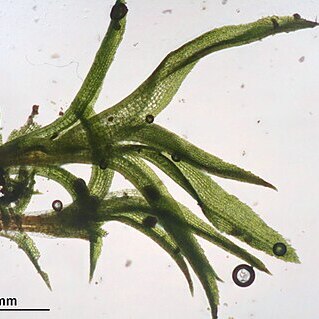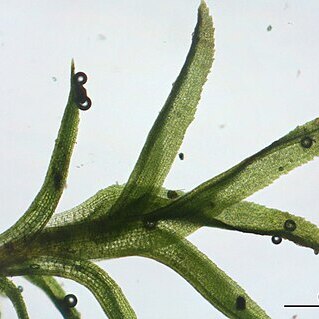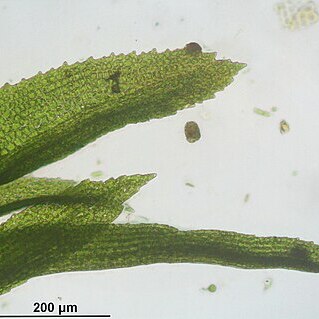Plants green above, light brown below; terricolous. Stems up to 5 mm tall, branching by subperichaetial innovations, tomentose below; rhizoids reddish brown, smooth; in section with cortical cells thin-walled, outer 1 or 2 rows smaller, epidermis not differentiated. Leaves larger above, crisped when dry, erect to erect-spreading when wet, recurved; narrowly oblong-lanceolate, narrowly ligulate or linear-lanceolate, 1.0-2.3(-3.2) mm long; keeled; apex acute or occasionally acuminate; base scarcely differentiated, ± sheathing; margins plane or frequently recurved on one side below, irregularly denticulate or serrulate, flexuose above. Costa ending below apex, ventral superficial cells rectangular, dorsal superficial cells linear; in section crescent-shaped, ventrally flat, lamina ventrally inserted, guide cells in 1 layer, ventral stereid band absent, ventral surface cells incrassate, dorsal stereid band small, dorsal surface cells incrassate or substereids, bulging. Upper laminal cells irregularly rounded-quadrate or rounded-hexagonal, incrassate, bulging, 11.2-17.5(-20.0) µm, smooth, in (5-)7-9(10) rows on each side of costa at leaf middle, in (4)5 or 6(7) rows just below apex; basal cells rectangular, thin-walled. Autoicous. Perigonia terminal on short branches below perichaetia, inner leaves ovate. Perichaetia terminal, leaves scarcely differentiated. Seta 1.6-2.7 mm long, yellowish brown, twisted anticlockwise above. Capsule exserted, ovoid, 0.4-0.8 mm long, yellowish brown to brown, weakly 8-ribbed, neck short; exothecial cells irregular-rectangular, smaller at mouth, cells of ribs weakly differentiated; stomata few, on neck, phaneropore. Peristome single, inserted below mouth, fugacious, teeth not seen, basal membrane low, orange. Operculum 0.5-0.7 mm long. Calyptra 0.8-1.2 mm long, smooth, naked. Spores 16.0-22.5(-25.0) µm.
More
Plants 0.5-1 cm, occasionally taller. Leaves 2-3.5 mm, crisped when dry, narrowly lanceolate, gradually tapering to an acute apex, margins serrulate with small teeth distally, distal cells subquadrate, 10-14 µm wide, often wider than long, somewhat incrassate. Seta 2-4.5 mm. Capsule 0.7-1 mm; peristome teeth linear to linear-lanceolate, broadened at base, smooth to striolate, perforate or irregular. Spores 15-21 µm.



